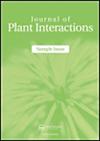Transcriptomic and physiological analysis reveals crucial biological pathways associated with low-temperature stress in Tunisian soft-seed pomegranate (Punica granatum L.)
IF 3.3
3区 生物学
Q2 PLANT SCIENCES
引用次数: 0
Abstract
ABSTRACT Low temperature severely affects the growth of pomegranate in the early spring during the production process under protected cultivation. To understand the molecular responses to cold stress in Tunisian soft-seed pomegranate, this study investigated the transcriptome profiles and physiological changes of pomegranate leaves exposed to cold stress (6 °C) and freezing stress (0°C). Some potential cold response/resistance genes involved in plant hormone signal transduction, photosynthetic systems and carbon fixation in the C4 pathway, and sucrose and galactose metabolism were identified. In addition, an analysis of physiological indicators indicated that both stresses caused cell membrane damage; the accumulation of soluble sugar, soluble protein and proline; and the occurrence of photoinhibition owing to the damage in photosynthetic apparatus and the decrease in light energy conversion efficiency and electron transfer rate as shown by the decrease in net photosynthetic rate [Pn], potential maximum photochemical efficiency of PSII [Fv/Fm], actual photochemical efficiency of PSII [YII] and photochemical quenching coefficient [qP], and the effect was much moresevere in pomegranate under freezing stress. This study results offer useful information to understand the molecular mechanism of pomegranate response to cold stress and also lay a foundation for the selection of major candidate genes to conduct molecular breeding for cold tolerance in pomegranate.转录组学和生理学分析揭示了突尼斯软籽石榴低温胁迫的关键生物学途径
本文章由计算机程序翻译,如有差异,请以英文原文为准。
求助全文
约1分钟内获得全文
求助全文
来源期刊

Journal of Plant Interactions
PLANT SCIENCES-
CiteScore
5.30
自引率
6.20%
发文量
69
审稿时长
>12 weeks
期刊介绍:
Journal of Plant Interactions aims to represent a common platform for those scientists interested in publishing and reading research articles in the field of plant interactions and will cover most plant interactions with the surrounding environment.
 求助内容:
求助内容: 应助结果提醒方式:
应助结果提醒方式:


